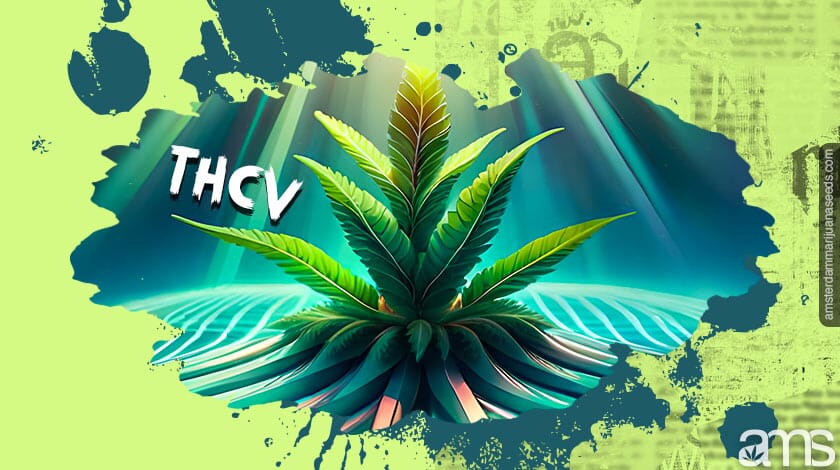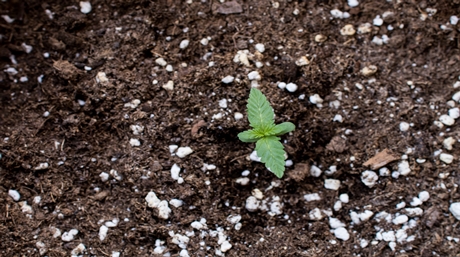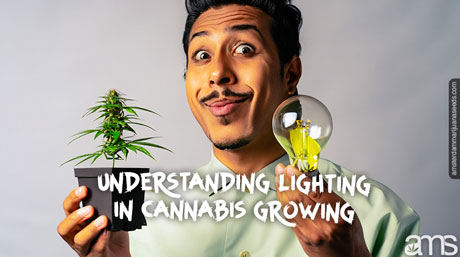General topics
what you need to know about this emerging cannabinoid
Published
2 years agoon
By
admin
The world of cannabis is ever-evolving, and new compounds are continuously being discovered with unique properties and potential health benefits. One of these compounds is THCV or tetrahydrocannabivarin, which is gaining popularity as an emerging cannabinoid with many therapeutic benefits.
Despite being discovered in the 1970s, it was not until recently that researchers began to explore its full potential. In this article, we will dive into everything you need to know about THCV, including what it is, how it works, its potential benefits in areas such as weight loss, diabetes, bone health, anxiety, and neuroprotection, and any possible side effects to consider.
So buckle up and keep reading. You might be surprised by what you learn about this emerging cannabinoid!
THCV (tetrahydrocannabivarin) is a minor cannabinoid found in small amounts in some strains of cannabis. It is structurally similar to THC (tetrahydrocannabinol), the primary psychoactive compound in cannabis, but it produces different effects. THCV was first discovered in the 1970s, but researchers have largely overlooked it until recently.
THCV interacts with the CB1 and CB2 receptors in our endocannabinoid system, just like THC and CBD. However, it produces different effects because it has a slightly different molecular structure. THCV has been shown to act as a partial agonist at the CB1 receptor, meaning it can activate and block the receptor. It also potentially affects other receptors, such as the serotonin 5-HT1A receptor and the dopamine D2 receptor.
THCV Compared with THC and CBD
THCV, THC, and CBD are three different compounds in the cannabis plant, each with unique structures and effects on our endocannabinoid system.
THCV vs THC
Although structurally similar, THCV and THC produce different effects due to their interaction with CB1 receptors in our endocannabinoid system.
THC is a psychoactive compound commonly known to produce the “high” associated with the use of cannabis. It can produce a range of effects such as relaxation, altered perception of colours, sounds or feelings, increased appetite, dry mouth and eyes, and in some cases, paranoia and anxiety.
In contrast, THCV, while still able to bind to CB1 receptors, has a milder psychoactive effect and can even counteract THC’s ability to produce the aforementioned “high” effect. THCV might not be ideal for recreational marijuana consumption and might be better suited for those seeking functional effects like increased energy, focus, alertness, and appetite suppression.
THCV vs CBD
CBD is a non-psychoactive cannabinoid and one of the most widely known and researched compounds in cannabis. Unlike THC and THCV, CBD does not bind well to CB1 receptors. Instead, it is thought to interact with a range of other receptors and ion channels in our body, which may result in anxiolytic, analgesic, anti-inflammatory, anti-epileptic, anti-psychotic, and neuroprotective effects.
THCV and CBD overlap in their therapeutic potential, particularly concerning weight loss and type 2 diabetes. However, there are some significant differences in their action mechanisms and effects.
THCV can help with weight loss by reducing appetite, increasing metabolism and energy expenditure, and decreasing fat levels while also improving insulin sensitivity and glucose control, making it potentially helpful for type 2 diabetes. Some studies have also shown that THCV can have neuroprotective effects, particularly beneficial for people with neurodegenerative disorders, such as Alzheimer’s and Parkinson’s disease.
Conversely, CBD is more commonly used to combat anxiety, stress, and depression. Studies have also suggested CBD could reduce inflammation, pain, and seizures and improve sleep quality.
Different Ways to Consume THCV
THCV can be consumed in several ways, similar to how other cannabinoids are consumed. Here are some different ways to consume THCV:
Smoking
Like THC-heavy strains of cannabis, some strains of marijuana contain relatively high amounts of THCV. Smoking cannabis that contains THCV can provide users with the benefits of the THCV cannabinoid. However, smoking is not always the healthiest method of consuming THCV or THC, and it can negatively impact people with respiratory issues.
Vaping
Vaping cannabis extract is a relatively healthier method of consumption compared to smoking. Vaping is a discrete and easy method to consume THCV or other cannabinoid extracts. As vaping is relatively new, there is little information available concerning the long-term health effects of vaping.
Tinctures
Cannabis tinctures are oral drops mixed with alcohol or other oils that can be consumed orally or sublingually (under the tongue). Tinctures are easy to use as a consumer can administer a precise amount of the product. Tinctures with THCV generally take effect quickly, with the impact able to last a few hours for some people.
Edibles
Edibles are a convenient way to consume THCV-infused food products. The effects of edibles can generally last longer than inhalation methods of consumption. However, consumers must also be cautious about consuming too much, as edibles can produce powerful and long-lasting effects.
Capsules
Similar to standard vitamins, THCV capsules come in standardized doses that are easy to consume. Capsules with THCV can offer users a precise amount of the cannabinoid.
Potential Benefits of Consuming THCV
THCV has a wide range of potential therapeutic benefits, which researchers around the world are studying. Some of the most promising areas of research include:
Weight loss
THCV has been shown to reduce appetite and increase metabolism in animal studies. This could make it a helpful tool for weight loss in humans.
Diabetes
In animal studies, THCV has been shown to improve glucose tolerance and insulin sensitivity. This makes it a potential treatment for type 2 diabetes.
Bone health
THCV has been shown to promote bone growth and reduce bone loss in animal studies. This makes it a potential treatment for osteoporosis.
Anxiety and PTSD
Cannabis may offer potential benefits for reducing anxiety and PTSD symptoms due to its interaction with the endocannabinoid system in the brain. Its main components CBD and THC work together to offer soothing and sedative effects to its users and help alleviate the symptoms of anxiety and stress.
Neuroprotection
The endocannabinoid system plays a key role in regulating various physiological processes, including those related to the central nervous system. That is why cannabinoids like CBD and THC which are present in cannabis plants offer various neuroprotective effects. This helps slows down or cure mental illnesses such as Alzheimer’s Disease, Parkinson’s, and more.
Other Notable Benefits
In addition to the potential therapeutic benefits already mentioned, THCV has been shown to have other notable benefits that are worth exploring:
- Anti-inflammatory properties: THCV has demonstrated anti-inflammatory properties that benefit people with various autoimmune disorders, such as rheumatoid arthritis and multiple sclerosis.
- Reduсed рanic attacks: Somе studies have shown TНCV may hеlp rеducе рanic attacks by moderating the effeсts оf ТHC. It could make cannabis use morе tolerаble for pеoplе who аre suscеptiblе to ТHC-induced рanic attacks.
- Reduced motor control problems: THCV may help reduce motor control issues from THC use. It may be useful in treating situations where cannabis use has led to motor control problems, such as Parkinson’s disease.
- Cut down cigarette addiction: A study from 2013 showed that THCV could potentially reduce nicotine withdrawal symptoms and may prove useful in treating cigarette addiction.
Possible Side Effects of Consuming THCV
Like any other compound, anything that is too much for our system to handle is harmful. That is why it is always best to note your dosage and level of tolerance. Here are some of the dangers of going beyond your limits:
Stimulating effects
As explained earlier, THCV offers psychoactive effects because it has a similar molecular structure to THC and binds to the same cannabinoid receptors in the brain, though with different effects. While THC is known for its sedative effects of letting users experience a feeling of euphoria, THCV on the other hand offers energizing effects that uplift the mood of its users.
Drug interactions
THCV is said to interact with CYP enzymes, which are responsible for the metabolism of many drugs in the liver. When this happens, it can affect the way other drugs are metabolized in the body, leading to decreased efficacy or increased toxicity of certain drugs. That is why it is important to always keep it in moderation when ingesting THCV.
Unknown safety profile
THCV may offer an unknown safety profile due to the limited research conducted on this particular cannabinoid. While there are some initial tests done on animal subjects, there are still limited cases showcasing its success for human consumption.
Cannabis Strains Rich in THCV
When you are looking for cannabis strains with high levels of THCV content, here are some of our recommendations:
Durban Poison
One of the most popular strains known for having high THCV content is Durban Poison, which is known to produce a focused and energetic high. Due to its unique profile, genetic origin, and effects Durban Poison is a highly valued strain. With high THCV levels, Durban Poison is great in alleviating stress, anxiety, and depression. It offers stimulating effects to its users as it regulates mood and boosts energy levels.
Skunk #1
This strain is a 50/50 hybrid of three original landrace strains—Acid, Afghani, and Mexican Sativa—which gives it a balance of Indica and Sativa traits. It also has higher-than-average levels of THCV, which makes it popular among those seeking the functional effects that this cannabinoid can provide.
Pineapple Purps
This strain is a blend of Pineapple, Skunk #1, and genetics from California, known as a “purps,” producing high levels of both THC and TCHV.
Willie Nelson
Willie Nelson is a cannabis strain named for the music legend and activist Willie Nelson. This Indica-dominant strain is a cross between an unknown South African Sativa and an Oregon Afghani Indica and produces high levels of THCV in addition to other minor cannabinoids. The high levels of THCV are what make this strain popular among those seeking the functional effects that this cannabinoid can provide.
Bottomline: Understand Before You Consume
THCV is an emerging cannabinoid that has the potential to produce a wide range of therapeutic benefits. While it is not yet widely available in commercial cannabis products, it is beginning to attract the attention of researchers and product developers.
As more research is conducted, it is likely that we will learn more about the potential of THCV as a therapeutic agent. In the meantime, people interested in using THCV should use it with caution and be aware of the potential risks and side effects.
Disclaimer: This content is meant for educational purposes only. It has been compiled with research from external sources. it is not meant to substitute any medical or legal advice. Please see your local laws for the legality of cannabis use.
You may like
-


Trump research cuts threaten cannabis studies, poses rescheduling questions
-


Cocaine Hub Seized by Rebels, Thwarting Colombia’s ‘Total Peace’
-


SEO for Cannabis? – How to Build Top Rankings for Your Cannabis Brands in 2025
-


Montanans must activate to protect legalization in 2025
-


Analysis: Don’t hold your breath for legalization under Trump 2.0
-


Pot for Potholes? – Michigan Plans to Let Cannabis Tax Revenue Fix the Growing Pothole Problem in the State

Many people often wonder how they can make cannabis hashish. Popularly shortened to hash, it is an Arabic name that means grass. Over countless years, this concentrate from the cannabis plant has been utilized by many cultures for its beneficial properties.
Today, the growing curiosity about how to make cannabis hash prompts us to come up with an ultimate guide on how the process can be done in a straightforward manner.
Producing hash requires separating cannabis bud trichomes from the other plant parts. In female cannabis plants, there are frosty white hairy-like structures. In this case, that’s what we refer to as trichomes. These parts are highly abundant in THC, which is why they are the most desired part of the plant. Remember that to come up with viable hashish, you must extract substantial amounts of THC.
Kief vs. hashish
Hashish doesn’t come merely from the separation of trichomes. The important factor at this point is kief. Kief is the raw material that aids in the production of hashish. When heat and pressure are applied to kief, hashish comes into existence.
Making kief into hash
From kief, it’s easy to come up with hash. There are two ways in which one can complete the process:
• Pollen pressing
• The heat and pressure method.
The pollen processing method
Pollen Processing involves placing kief in a press. Next, you apply firm pressure to make it moldable. By applying direct pressure to the kief, you will create a basic hash (really a kief puck). This method makes it easier to come up with a puck of hash.
However, this method has disadvantages. The flavors do not get a chance to develop, as there is no heat used in the process. The heat assists in developing and maintaining the flavors of the hash in its finished form. Heating and applying pressure to kief gives you a higher-quality hash.
The heat and pressure method
You can use the puck that you created above, or you can use cellophane to wrap kief and use a rolling pin to apply pressure and create a puck. Just keep gently applying pressure until the kief is at the density and shape that you want. You can continue to do this as long as you want. You can also let it sit for a day or two so that all of the flavors meld together. When you are ready, remove the cellophane.
Once you have created a kief puck using a pollen press, to do the heat and pressure method, you will need to gently heat the kief. You will want to wrap the puck in a wet paper towel. You will then wrap the kief in a wrap that can withstand being in a 93 – 137°C (200 – 280°F) oven. A good cooking parchment paper will be perfect for this application.
Place the parchment paper and its contents in an oven set somewhere between 93 – 137°C (200 – 280°F). Make sure that the contents do not spill out. Having a baking sheet handy would be very helpful here. Place the package in your oven for 5-10 minutes. Unwrap the package. Rewet your paper towel, re-press your puck using the method above, and then rewrap it in parchment paper. Place this in the oven again for 5-10 minutes. Repeat the process. You want to do this whole process at least three times. Let it cool overnight or by placing the product in your fridge or freezer.
The pressure and heat method will produce a superior hash.
Methods used in the production of hashish
There are other different methods used in coming up with hash. However, these ways give different potency levels.
It is also worth mentioning that different cannabis plants have different cannabinoid levels. That said, they can produce varied qualities of hash depending on the marijuana strain used. There are quite a few methods used to make cannabis hash. Nonetheless, we are going to give the three most used and cheap to try at home.
1. Finger production method
This could be described as the easiest method for producing hash. As one harvests ganja from the cannabis plants, there may be instances where it sticks to the palms and the fingers.
The method involves placing a can or jar and rubbing your hands and fingers together over the can so that it collects the parts of the buds that stick to your hands. This can then be used to produce hash by rubbing your hands together vigorously. The heat and pressure produced during rubbing aid in combining the mixture into hash. However, this type of hash is described as having low quality. There may also be contamination coming from sweat and dirt on your hands.
The obtained hash may have off-flavors and unpredictable effects, which is a negative.
2. Silkscreen
This method involves sieving cannabis trichomes through a silk screen. Depending on your preference, you can opt to make your silkscreen or purchase one. Either way, note that the cannabis plant parts must be trimmed into very tiny sizes through this screen.
That said, you also need to ensure that you see the trichomes and collect them painstakingly. The finer the silkscreens that you use, the higher the probability of coming up with finely produced hashish.
One can opt to use the remains to sieve them further. However, the kief obtained from the get-go usually has mostly potent hashish. Depending on the amount of hash needed, a single silkscreen is under most circumstances sufficient to come up with a substantial amount of hash.
3. Blender method
The blender method relies heavily on probability. The colder the trichomes, the easier it gets to separate them from the rest of the cannabis plant parts. Ice is a crucial ingredient in this method. Using this method involves mixing the cannabis plant matter, water, and ice into a blender.
Switching on the blender aids in separating the iced plant matter to get the trichomes. That becomes evident after switching off the blender. The trichomes sink, making it easy to obtain them promptly.
A sieve can then get used. The trichomes penetrate easily, which is why they pass through the sieve with water while the rest of the plant parts remain in the sieve.
Letting the trichomes and water mixture cool for 30 minutes afterward helps the trichomes form a layer at the bottom. However, one ought to be careful because slight disturbance to the trichomes can lead to unnecessary impurities. The trichomes layer can then get placed in a freezer for ten minutes.
In summary
Making hash is a sure way to make trichomes usable in a unique way. Now that you have the info necessary to come up with these concentrates, the ball is in your court.
The marijuana strains you use to extract the trichomes play an essential role in the overall effects obtained after using hashish. The better the strain you use, the better your hash will be.
Follow the method of your choice and enjoy your hash to the fullest!
General topics
How To Make Hash Or Hashish, Expert Tips!
Published
2 months agoon
December 14, 2024By
admin
Hashish is a cannabis concentrate. It is wonderful stuff that you can crumble and put in a joint or smoke in a bowl. You can buy it from a dealer, but did you know that you can also make it relatively easily yourself? You don’t need that much at all. There is even a method that requires no tools at all, just your hands! Read on and make your own hash! In this article we’ll discuss two methods, namely making hash using a sieve and making hash using a blender.

Make hashish with a sieve
There are different ways to make hashish. For example, you can roll your plant material under your hands. Because you press hard and roll, the trichomes stick to your hands. A sticky layer will remain on your hands, and if you carefully scrape it off, you will have hash!
Rolling is a simple method because you don’t need anything for it. Well, of course, you need plant material. You can use stems, leaves, and flower tops for it. In fact, everything that remains after harvesting still has trichomes. There are trichomes on almost all parts of a weed plant. Sometimes there aren’t that many, but by rolling everything under your hands, enough sticks. Suppose you don’t like this method, for example, because you don’t want to get your hands dirty, there are many more ways to make hash. So read on, and discover other ways that might be of interest to you. Keep in mind that every way to make hash produces a different kind of hash. A certain method influences the structure, for example, the hash may end up being a bit dry or very sticky. And how strong the hashish is can differ. But that is just the fun. With every method you use, the end product is about the same, since it falls into the hashish category. Yet there are differences in the final product that make it interesting again. Certainly, if you make it yourself, you can vary nicely. That way you learn what you like best. Anyway, we want to teach you a method here that is very simple. The only thing you need for it is a sieve. This method is also called ‘flat screening’. Use a strainer that you can easily hold in your hand, the smaller the holes, the better and purer your final product will be. We assume that you are looking for quality, not quantity!
It is best to first put your weed in the freezer for a while. That will help to get the trichomes off your weed plant better. When you have done that, remove the plant material from the freezer. Make sure you have a clean work table or surface. Put the plant material on the sieve and rub it very carefully back and forth. By rubbing the plant material remains on the sieve and the trichomes fall through the fine holes of the sieve. The trichomes fall on the surface under the sieve. Continue to sift for a while, until no more trichomes fall and the plant material is ‘finished’.
Making hashish in a blender
Of all the ways to make hashish, this is perhaps the coolest. And it is not only very fun to do, but it is also very simple. You probably have all the materials for this method at home. You need a blender and a strainer (sieve) for it. Are you ready to make your own fresh, wonderfully smelling, homemade hashish? Here we go!
Put all the cutting residues that you have left after pruning or harvesting in a blender. Now fill the blender with water so that all the plant material is just covered with water. Wait, don’t start mixing right away. We appreciate your enthusiasm! But ice must first be added. Fill the blender completely with ice. Now it’s time to mix. First do it a bit quietly, so that the ice can crush, and then turn the blender knob all the way to high-speed mode, and mix for a minute at the highest setting. You now get a kind of green soup, a bit of a slimy mixture. Now take the sieve and keep it above a jug or a pot. Pour the green mixture through the sieve into the jug and let it rest for about an hour. You now see something very nice happening: the trichomes form on the bottom. If you want to see this, you must take a glass can. Then you can see it all happen. Now comes a precise job, which you have to handle carefully. Drain part of the water, but watch out, make sure you don’t wash away the trichomes because you want them! Now fill the pot again with very cold water and let it rest for 10 minutes. Drain part of the water again and be careful not to wash away the trichomes. You have to be patient now, and not make it easy for yourself. Just wait and restrain yourself for a moment! For good quality hashish, you have to repeat this process about 6 times.
We will now make real hashish
Did you do all this? Beautiful! Then we will now make real hashish. Start by carefully draining as much water as possible from the jug (or pot, depending on what you use). So don’t rinse the trichomes away, otherwise, you can start over again, and you will have better things to do! Now grab a filter. A coffee filter works best. Carefully pour the solution left in the jug through the coffee filter. Now all the water is washed away and a sticky mass remains in the filter. Tadaaa, there is your homemade hash! Congratulations! First, gently squeeze the filter to remove even more water, pressing the hashish slightly. You can now let it dry and then smoke it in a bowl or joint, just what you like best. It is not necessary to first heat the hash or compress it even further. Enjoy!
Cannabis FAQ
Expert Lighting Tips For Successful Indoor Growing Weed
Published
3 months agoon
November 22, 2024By
admin
Cultivating Your Green Haven Year-Round
As the cold weather approaches and outdoor growers retreat indoors to continue their cultivation throughout the winter, the importance of choosing the right lighting for indoor growing becomes paramount. With a myriad of illumination options available, it’s easy to feel overwhelmed. But fear not, for we are here to guide you through the process, helping you create a thriving indoor garden that will yield bountiful results throughout the year.

Illuminate the Path to Successful Indoor Growing Weed
When it comes to indoor cultivation, lighting is undeniably one of the most crucial factors to consider. Not only does lighting play a vital role in manipulating the natural light cycles of marijuana plants, but it also serves as, the catalyst for photosynthesis—the process by which plants create their own, nourishment. Within the leaves of cannabis plants, chlorophyll acts as a light-absorbing pigment, harnessing light energy to convert water and carbon dioxide into food sugar.
The process of photosynthesis is directly influenced by the color, duration, and intensity of light received by the plant. By strategically altering these factors, you have the power to impact your plant’s food production. Cool blue and warm orange are examples of illumination colors that enhance a plant’s ability to generate sustenance. During the summer months, cool light is most beneficial, promoting dense and well-shaped growth. In contrast, warm-colored light during the fall harvest months induces the development of vibrant flowers. In essence, cool colors stimulate growth, while warm colors act as catalysts for flowering.
Embracing Darkness: The Role of Light Cycles
Beyond light color, the duration of light exposure your cannabis plant receives is of utmost importance. By adhering to specific light cycles, you can ensure optimal growth and flowering. During the growth phase, it is recommended to provide your young plants with 18 hours of light and 6 hours of uninterrupted darkness. This extended period of light exposure fuels vigorous vegetative growth. However, once the plant is ready to flower, adjusting the light cycle to 12 hours of light and 12 hours of darkness triggers the flowering process.
The flexibility of indoor cultivation allows you to customize the light cycle based on your preferences and the needs of your plants. This is especially beneficial during the winter months when maintaining a consistent temperature is challenging. By utilizing the ability to leave the lights on during the night and off during the day, you can create a more stable environment, minimizing temperature fluctuations and providing a nurturing space for your plants.
Choosing the Right Lamps: Illuminating Your Indoor Oasis
Selecting the appropriate lamps for your indoor grow room requires careful consideration of various factors. Firstly, assess the amount of light intensity required for your plants’ growth stage. Secondly, consider the size of your grow room, as this will determine the number and placement of lamps needed. It is essential to evaluate the electrical capabilities of the room to ensure that the chosen lamps can be adequately powered. Additionally, contemplate the preferred light color that aligns with the specific growth stage and desired outcomes. Lastly, establish a budget and compare the prices of different illumination options, keeping in mind that lighting systems are long-term investments that can incur higher costs due to their power consumption.
Fluorescent lamps with a broad color spectrum are particularly beneficial for seedlings that have not yet developed large leaves. These lamps provide ample light and support the initial stages of growth.
Indoor growers seeking maximum intensity per watt would benefit from high-pressure sodium lamps (HPS). Known for their efficiency and cost-effectiveness, HPS lamps emit a warm orange glow, which triggers plant hormones that facilitate bud development and flowering. While HPS lamps excel at providing warm light, they are less proficient in emitting cool blue light. Consequently, they are best suited for the flowering stage of growth. If you were to use an HPS bulb for seedlings, it is advisable to keep the lamps at a lower height (approximately 80 cm/31.50 inches) to encourage rapid horizontal growth. Early pruning can also help control plant height and prevent excessive stretching.
On the other hand, metal halide lamps (MH) are highly efficient and serve as an excellent primary light source for indoor growers. Emitting one of the brightest cool lights available, MH lamps are ideal for promoting foliage growth and cultivating robust plants. With an average lifespan of 10,000 hours, MH lamps retain their glow for an extended period. However, it is important to note that over time, the energy they emit within the blue range diminishes. Therefore, regular assessment and potential replacement of MH lamps are necessary to maintain optimal illumination conditions.
Expert Tips for Successful Indoor Growing Weed
To ensure the success of your indoor cultivation journey, consider the following tips:
- Maintain Adequate Distance: Pay close attention to the proximity of your plants to the light source. If the lamps are too close, they may cause light burn and damage your precious foliage. Strive to maintain a safe distance between the lamps and plants to avoid such undesirable outcomes.
- Achieve Balance: Provide all your plants with a consistent and equal amount of light. Avoid overcrowding, as taller plants may overshadow their smaller counterparts, depriving them of much-needed light. To overcome this challenge, consider using bins or adjustable platforms to elevate smaller plants closer to the light source, ensuring equitable light distribution.
- Cultivate a Year-Round Bliss: Embrace the advantages of indoor cultivation, relishing a year-round supply of your favorite buds. Although setting up your indoor oasis may seem initially daunting, the rewards will be reaped one bud at a time. With careful attention to illumination, you can create an optimal environment for your plants to thrive regardless of the season.
In conclusion, selecting the ideal illumination system for indoor growing is a decision that warrants thoughtful consideration. By understanding the profound impact of light color, cycle duration, and intensity on your plants, you can make informed choices that maximize yield potential. Whether you opt for fluorescent lamps, high-pressure sodium lamps (HPS), or metal halide lamps (MH), remember to strike a balance and provide optimal conditions for your plants to thrive. Embrace the joys of indoor cultivation and revel in the delights of a bountiful harvest, regardless of the season.

Trump research cuts threaten cannabis studies, poses rescheduling questions

Cocaine Hub Seized by Rebels, Thwarting Colombia’s ‘Total Peace’

SEO for Cannabis? – How to Build Top Rankings for Your Cannabis Brands in 2025

Montanans must activate to protect legalization in 2025

Analysis: Don’t hold your breath for legalization under Trump 2.0

Pot for Potholes? – Michigan Plans to Let Cannabis Tax Revenue Fix the Growing Pothole Problem in the State

Karma Koala Podcast 232: Karina Bashir, Antithesis Law. Her work developing ESG & Corporate Practice Blueprint In The New Psychedelics Ecosystem

Medical cannabis registries show steep decline after launch of adult-use sales

Benefits and Uses of THCA Flower

The best weed-friendly travel spots of 2025

Distressed Cannabis Business Takeaways – Canna Law Blog™

United States: Alex Malyshev And Melinda Fellner Discuss The Intersection Of Tax And Cannabis In New Video Series – Part VI: Licensing (Video)

What you Need to Know

Drug Testing for Marijuana – The Joint Blog

NCIA Write About Their Equity Scholarship Program

It has been a wild news week – here’s how CBD and weed can help you relax

Cannabis, alcohol firm SNDL loses CA$372.4 million in 2022

A new April 20 cannabis contest includes a $40,000 purse

Your Go-To Source for Cannabis Logos and Designs

UArizona launches online cannabis compliance online course
Trending
-

 Cannabis News2 years ago
Cannabis News2 years agoDistressed Cannabis Business Takeaways – Canna Law Blog™
-

 One-Hit Wonders2 years ago
One-Hit Wonders2 years agoUnited States: Alex Malyshev And Melinda Fellner Discuss The Intersection Of Tax And Cannabis In New Video Series – Part VI: Licensing (Video)
-

 Cannabis 1012 years ago
Cannabis 1012 years agoWhat you Need to Know
-

 drug testing1 year ago
drug testing1 year agoDrug Testing for Marijuana – The Joint Blog
-

 Education2 years ago
Education2 years agoNCIA Write About Their Equity Scholarship Program
-

 Cannabis2 years ago
Cannabis2 years agoIt has been a wild news week – here’s how CBD and weed can help you relax
-

 Marijuana Business Daily2 years ago
Marijuana Business Daily2 years agoCannabis, alcohol firm SNDL loses CA$372.4 million in 2022
-

 California2 years ago
California2 years agoA new April 20 cannabis contest includes a $40,000 purse



